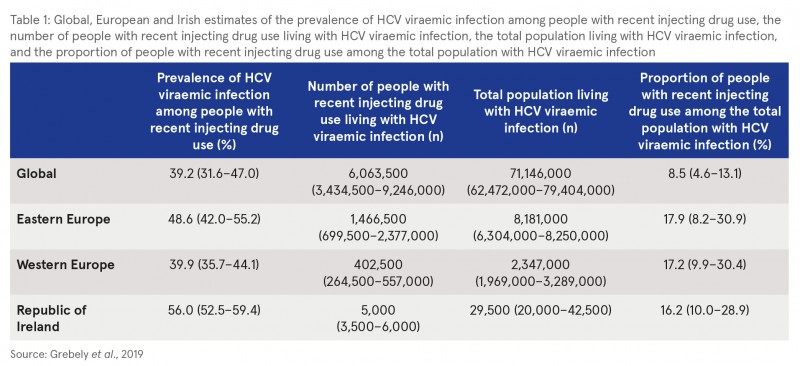Millar, Sean (2019) Global, regional and country level estimates of HCV infection among recent injecting drug users. Drugnet Ireland, Issue 69, Spring 2019, pp. 13-14.
| Preview | Title | Contact |
|---|---|---|
|
PDF (Drugnet Ireland 69)
1MB |
The World Health Organization has set a goal to eliminate hepatitis C virus (HCV) as a global public health threat by 2030. Targets include reducing new HCV infections by 80% and the number of HCV deaths by 65%, and increasing HCV diagnoses from 20 to 90% and eligible people receiving HCV treatment from <5 to 80%.1 Unsafe injecting drug use is the main route of HCV transmission in developed countries.2 Consequently, people who inject drugs (PWID) represent a priority population for HCV elimination, given the high prevalence and incidence in this group.
There are no previous global estimates of HCV prevalence among people with recent injecting drug use. Data on these are needed in order to monitor the progress of global HCV elimination efforts and to identify high-burden settings which should be targeted. A recent study estimated the prevalence and number of people with recent injecting drug use living with HCV, and the proportion of people with recent injecting drug use among all people living with HCV infection, at global, regional and country levels.3
In this research, published in the journal Addiction, data from a global systematic review of injecting drug use and HCV antibody prevalence among people with recent (previous year) injecting drug use were used to estimate the prevalence of people with recent injecting drug use living with HCV. These data were then combined with a systematic review of global HCV prevalence to estimate the proportion of people with recent injecting drug use among all people living with HCV.
Results
Global and regional estimates
Globally, it was estimated that in 2015, 39.2% (95% CI: 31.6–47.0) of people with recent injecting drug use had HCV viraemic infection, representing 6.1 million subjects (95% CI: 3.4–9.2) with recent injecting drug use living with HCV infection. Of the 71.1 million (95% CI: 62.4–79.4) people living with HCV infection, it was estimated that 8.5% (95% CI: 4.6–13.1) were recent injecting drug users, with the greatest proportion in North America (30.5%), Latin America (22.0%) and Eastern Europe (17.9%).
European and Irish estimates
Global, Eastern/Western European and Irish estimates are shown in Table 1. For the Republic of Ireland, it was estimated that in 2015, 56% (95% CI: 52.5–59.4) of subjects with a history of recent injecting drug use had HCV infection, representing 5,000 (95% CI: 3,500–6,000) individuals. Of the total number of people with HCV infection in Ireland in that year (n=29,500, 95% CI: 20,000–42,500), it was estimated that 16.2% (95% CI: 10.0–28.9) were individuals who had recently injected drugs.

Conclusions
The authors noted that there were wide variations among regions and countries with regard to HCV prevalence among recent injecting drug users and the proportion of injecting drug users among the total population with HCV infection. They suggest the research highlights that concerted efforts will be required in countries with large numbers of people infected with HCV in order to achieve global HCV elimination among PWID.
1 World Health Organization (WHO) (2017) Global hepatitis report, 2017. Geneva: WHO. https://www.drugsandalcohol.ie/27177/
2 Nelson PK, Mathers BM, Cowie B, Hagan H, Des Jarlais D, Horyniak D, et al. (2011) Global epidemiology of hepatitis B and hepatitis C in people who inject drugs: results of systematic reviews. Lancet, 378(9791): 571–83. https://www.drugsandalcohol.ie/15845/
3 Grebely J, Larney S, Peacock A, Colledge S, Leung J, Hickman M, et al. (2019) Global, regional, and country–level estimates of hepatitis C infection among people who have recently injected drugs. Addiction, 114(1): 150–66. https://www.drugsandalcohol.ie/29394/
G Health and disease > Disease by cause (Aetiology) > Communicable / infectious disease > Hepatitis C (HCV)
J Health care, prevention, harm reduction and treatment > Health related issues > Health information and education > Communicable / infectious disease control
T Demographic characteristics > Person who injects drugs (Intravenous / injecting)
VA Geographic area > International
VA Geographic area > Europe > Ireland
Repository Staff Only: item control page